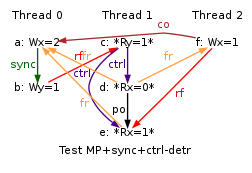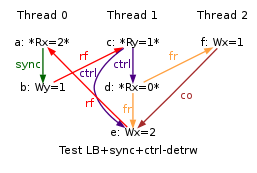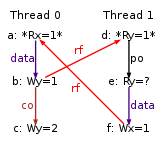


Tests
Test base
Our test base for Power
extends on the one of [2].
Most of our tests are produced by one of
the generators
of the diy tool suite
from cycles of candidate relaxations,
a concise and precise mean to describe violations of sequential consistency,
and thus relevant tests for memory model testing.
For instance, by listing critical cycles of size four,
we get all the six basic violations of sequential consistency on two
threads: 2+2W, LB, MP, R, S and SB. See the Quick reference for litmus test families for more such tests up to four threads.
Additional tests are:
-
Additional variations of the six two thread tests 2+2W, LB, MP, R, S and SB.
The variation of previous work [2]
consists in systematic enumeration of sequences of
intra-thread relations from one memory access to the next, including
address dependencies, data dependencies, control dependencies
and identity of addresses and applied to
the three tests MP, S and LB.
We extend on previous work by :
-
also considering the remaining three two thread tests
2+2W, R and SB;
- adding the eieio fence to systematic variations;
- and adding the so called “detours” to intra-thread
relations.
Detours are a short passage of test cycle by an extra thread
that performs a memory access.
For instance, here are two examples: LB+sync+ctrl-detrw and MP+sync+ctrl-detr.
Then, for instance in test MP+sync+ctrl-detr,
one notices the sequence fr; rf that passes through
Thread 2 at the end of Thread 1.
Detours are relevant to this work as they occur in the model definition.
Moreover, test MP+sync+ctrl-detr unveiled a
bug in the model of [3].
- Regression tests found during the development of
the current model, such as REG00, REG01, REG02 and W+RR+W+RW+RW+RR+sync+lwsync+sync+lwsync.
As can be seen from examples, those tests are
previously untested combinations of full fences,
lightweight fences and dependencies up to five threads.
The ARM test set is broadly similar, considering that ARM fences are different.
We considered ARM dsb and dmb fences, and their
variations dsb.st and dmb.st.
Finally our test set for Power
power-tests.tgz totals
8121 tests; while our test set for ARM
arm-tests.tgz
totals 9763 tests.
The purpose of this document is to illustrate the companion paper.
We do so by the means of tables.
Nevertheless, we also provide
model ouputs, complete logs of our experiments,
and test validation summaries.
What is a test?
Tests are of course programs that we either simulate or run
on actual hardware. As a result of those runs,
we collect the final values of
some observed locations, either local (i.e. registers) or
global (i.e. memory cells).
Observed locations can be given explicitly in test source but more
often they derive from a given final condition, a quantified boolean
proposition that appears at the end of test source.
In turn, an existential test condition identifies one of several executions
of a given test.
As described in Sec. 3 of the paper, an execution
is a set of events (memory accesses, fences and branch events),
plus a few relations: program order po,
and communication relations read-from rf and coherence order co
(plus some other relations such as dependencies or the from-read relation fr
which derive from the basic ones).
In effect, when we describe tests we more often describe
test executions than plain programs.
For instance, the web page for the MP test not only gives
the program (and final condition) as given by test source,
but also diagram(s) of execution as the following one
that here describes the non-SC
(non Sequentially Consistent) execution of the MP test:
Executions for behaviour:
"1:r1=1 ; 1:r3=0"

This diagram derives from the final condition that identifies
the situation when Thread 1 loads value 1 from location y and then
the value 0 from location x.
Notice that by changing the final condition of tests we get others
executions. For instance, we get the SC executions of MP as:
PPC MP
{
0:r2=x; 0:r4=y;
1:r2=y; 1:r4=x;
}
P0 | P1 ;
li r1,1 | lwz r1,0(r2) ;
stw r1,0(r2) | lwz r3,0(r4) ;
li r3,1 | ;
stw r3,0(r4) | ;
(* Was exists (1:r1=1 \/ 1:r3=0) *)
exists (1:r1=1 /\ 1:r3=1) \/ (1:r1=0 /\ 1:r3=0) \/ (1:r1=0 /\ 1:r3=1)
That is, we changed the final condition of MP to a new one
that lists the final values of the test when run on the SC model.
This results in the following three execution diagrams:
Executions for behaviour:
"1:r1=0 ; 1:r3=0"

Executions for behaviour:
"1:r1=0 ; 1:r3=1"

Executions for behaviour:
"1:r1=1 ; 1:r3=1"
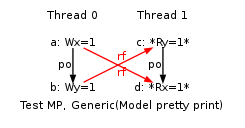
Ambiguous test executions
It is worth noticing that a given set of final values for all
observed locations may cover more than one execution.
For instance consider LB+data-pos+pos-data, a variation of
of LB:
PPC LB+data-pos+pos-data
{
0:r2=x; 0:r4=y;
1:r2=y; 1:r5=x;
}
P0 | P1 ;
lwz r1,0(r2) | lwz r1,0(r2) ;
xor r3,r1,r1 | lwz r3,0(r2) ;
addi r3,r3,1 | xor r4,r3,r3 ;
stw r3,0(r4) | addi r4,r4,1 ;
li r5,2 | stw r4,0(r5) ;
stw r5,0(r4) | ;
exists
(y=2 /\ 0:r1=1 /\ 1:r1=1)
By observing the final values of registers 0:r1 and 1:r1,
the above final condition targets some LB style non-SC execution
a → b → d → f, or more precisely:
But the register 1:r3 (second load of y by Thread 1) has
to get its value either from the initial value 0 of y,
or from the stores to y by Thread 0 (b or c).
This results in the following three executions:
Executions for behaviour:
"0:r1=1 ; 1:r1=1 ; y=2"

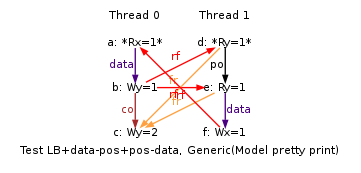
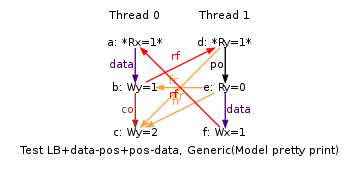
Notice that, in the above LB+data-pos+pos-data example,
the ambiguity in executions results from not observing the
register 1:r3. Unfortunately many of our tests present such
a lack of observation. To reveal that situation in execution diagram, we
picture observed reads between two stars ’*’.
For instance, in the above diagrams the first memory load by Thread 1 is written
“d:*Ry=1* ”, while the second memory load is written
“e:Ry=0”,“e:Ry=1”, and “e:Ry=2”.
Another source of ambiguity originates from tests that feature
three stores or more to the same location. Consider the simple test
3W:
PPC 3W
{
0:r2=x; 1:r2=x; 2:r2=x;
}
P0 | P1 | P2 ;
li r1,1 | li r1,2 | li r1,3 ;
stw r1,0(r2) | stw r1,0(r2) | stw r1,0(r2) ;
exists (x=3)
This tests consists in three threads each of which performs a store
to the global location x.
The final condition x=3 does not characterise an unique coherence
order: as the two orders a → b → c and
b → a → c admit the store of value 3 as their
last element.
Such ambiguity can be avoided by adding an extra thread to the test.
The new thread’s sole purpose is to read x three times,
saving the loaded values in registers that are observed,
see test 3W+OBS. We seldom use this possibility as such an
observation of coherence orders requires sheer luck to perform well
during hardware experiments. An alternative is to add some memory loads
to the test threads themselves, as in test 3W+OBS-LOCAL.
Unfortunately, this latter technique clutters execution diagrams, which become
barely readable, saved for the most simple tests.
Besides, those techniques assume that the tested system
does not permit loads to contradict the coherence order.
In our words, the tested system must obey the sc per location check.



